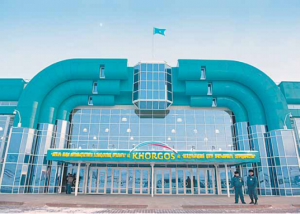On July 2, 2014, during a national teleconference, President Nursultan Nazarbayev initiated the construction of Khorgos – East Gate Free Economic Zone (FEZ) on the Chinese border.
A few months later in December, state-owned Kazakhstan Temir Zholy (Kazakhstan Railways) reported that the first part of the complex was ready for operation. President Nazarbayev called it a long anticipated facility, of which Kazakhstan has “high expectations” in terms of increasing trade between the two countries. The facility’s dry port is a leap for infrastructure in the area. It is expected that within the next two years, the facility will process more than 200,000 containers.
The constructors who built the facility understood its importance and the responsibility upon them. Ali Karabalin, the head of the technical supervision department for construction of the Free Economic Zone (FEZ), said that this project was one of the most challenging projects of his career. In summer 2014, he promised the company’s management that he would ensure that a container train would be running through the dry port in December. Skeptics scoffed, calling him “a dreamer.”
However, at the end of the year, trains were indeed successfully carrying containers across the newly laid railway. Kazakhstan Temir Zholy (KTZ) President Askar Mamin commended the speedy work; he is keeping the project under his special control and regularly inspects the building site.
In January, new tasks were given: assuring that the Khorgos dry port is functioning properly and creating conditions that would attract logistics and industrial investors.
Mamin is certain that 2015 will be a year of rapid growth at Khorgos – East Gate.
“The project is now well known to all major logistics companies operating in Eurasia that facilitate trade between Europe, Asia and the Gulf. Hewlett-Packard (HP), Toyota, DHL, our partners from the [Commonwealth of Independent States] CIS countries and many others are interested in the development of logistics systems at this FEZ. Therefore, all logistics associated with the construction of [the new railway links] Zhetygen-Khorgos, Zhezkazgan-Beineu, Kazakhstan-Turkmenistan-Iran, providing access to the Persian Gulf and the construction of a dry port [at Khorgos], create great transit potential. We must fully implement this project,” Mamin said.
Understanding the importance of Khorgos – East Gate is easier when one looks at the geographical and economic map of Eurasia. China is the largest industrial producer in the world, while Europe is the largest consumer market. Kazakhstan is located in the middle of the transit corridors connecting them.
“Khorgos – East Gate is the most important point along this entire route,” Mamin said.
“With the advantages of its geographic location and the infrastructure we are building, investors are already eager to develop logistics competencies here and build warehouses to service the entire Eurasian continent. Therefore, we must do as much as possible to make investors comfortable during their time here,” he stressed.
The KTZ head is confident that Khorgos – East Gate will be a strong driver of not only economic growth in the Almaty Oblast and Kazakhstan as a whole, but of economic growth across the whole of Eurasia. Cooperation with a strategic partner, the world’s largest port operator DP World (Dubai Port World), which manages Khorgos – East Gate via an agreement with KTZ, confirms the validity of such ambitions. Representatives of the management company say they are confident that the logistics area at Khorgos will be one of the most advanced in Eurasia.
Anil Singh, senior vice president and managing director of DP World, sees great prospects for growth in logistics at the FEZ. He believes Khorgos will provide them with a short and profitable route from southern China and Southeast Asia to Europe, the Persian Gulf and back. This is why KTZ is implementing this important project at an accelerated pace.
“It took more than 20 years to develop Dubai, but Khorgos may change beyond recognition in just 10 years,” he said.
The company that manages Khorgos – East Gate and the Altynkol station has already begun working on attracting container traffic and is finalising plans for the facility’s launch; rates will be fixed and the conditions for operations there will be set.
At the same time, work has begun on building modern living facilities for FEZ employees.
KTZ executives are confident that this grand project is progressing smoothly and its general success depend


